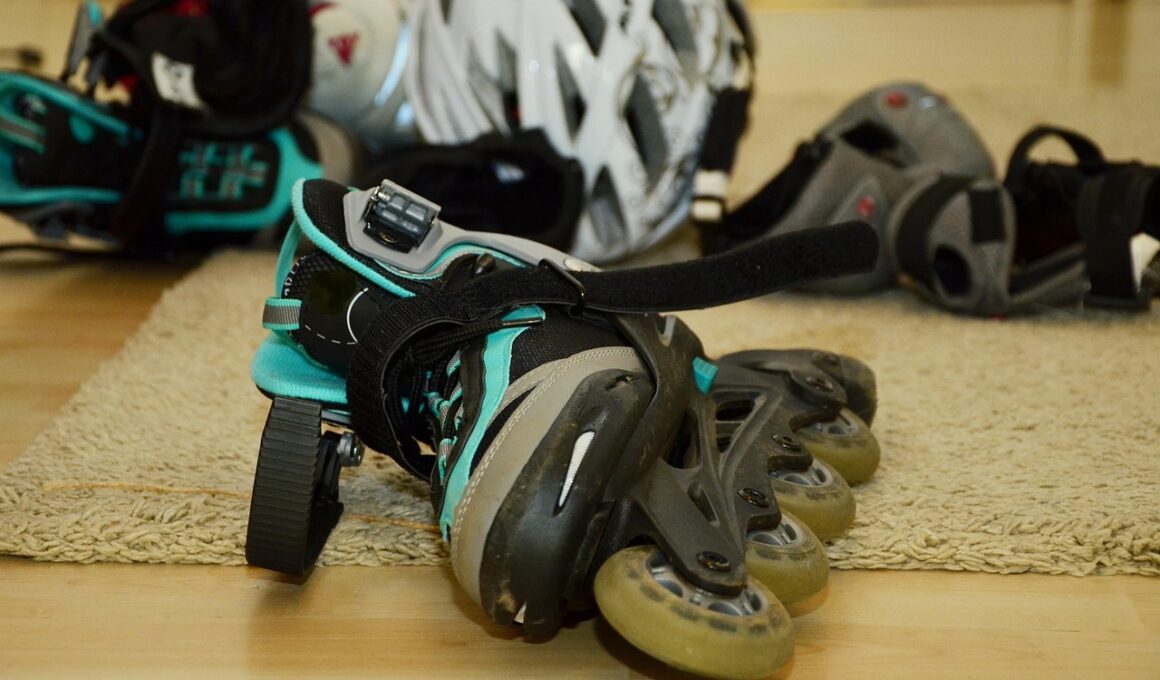How to Avoid Common Injuries in Inline Skating
Inline skating is a thrilling activity that offers both fun and fitness; however, beginners must take precautions to ensure their safety. Most injuries in inline skating occur from falls, collisions, or equipment-related issues. To minimize the risk of injury, it’s critical to wear protective gear such as helmets, wrist guards, knee pads, and elbow pads. Each piece serves to absorb shock and protect vulnerable areas. Be sure that your skates fit properly; loose skates can lead to instability and falls. Moreover, practice falling safely to help lessen the impact should you lose your balance. Finding a flat, smooth surface to skate on provides a safer environment for learning. Avoid busy streets and areas with pedestrian traffic. Skating with others can also enhance safety, as fellow skaters can help you keep an eye out for dangers. Be mindful of the skating conditions, including weather and surface quality. Rain, for instance, can make surfaces slippery. Lastly, mastering basic skills like stopping and turning will go a long way in preventing accidents and injuries. With diligence and attention to safety, beginners will certainly enjoy inline skating with confidence.
One of the most common injuries faced by inline skaters is wrist sprains. This often occurs when a skater instinctively reaches out their hands to brace for a fall. To combat this, wearing wrist guards can offer excellent support and prevent hyperextension of the wrist joint. Furthermore, it is essential to practice proper falling techniques. Attempting to fall on your side or rolling out of a fall can minimize the impact. If you do fall, try to relax your muscles to avoid extra strain. Another common area of injury is the knees. Properly fitting knee pads can cushion and protect them from harm. Regular stretching can also help in improving flexibility and lowering the chance of strains. Alternating between skating and other physical activities can prevent overuse of specific muscles. Utilize appropriate skating techniques, such as bending your knees and maintaining a low center of gravity during skates. Learning how to balance correctly can significantly reduce the risk of falls. Be vigilant of the surroundings and maintain a safe distance from other skaters. Thus, following these precautions can contribute to a safer inline skating experience and fewer injuries.
Importance of Proper Skating Technique
Beyond safety gear, adopting the right skating techniques is vital when aiming to avoid injuries. Beginners should take the time to learn the basics, like how to position their feet correctly in alignment, while skating. Legs should stay shoulder-width apart to ensure stability and control. Correct posture is also crucial; an upright position with slightly bent knees will help absorb shocks and maintain balance. To stop effectively, mastering the “T-stop” or the “heel brake” techniques will make a huge difference. These are essential skills that give you more confidence. Additionally, regular practice on technique can help solidify the muscle memory needed to perform these actions instinctively. When you feel more secure in your movements, you will be less likely to panic when faced with unexpected hurdles. It’s advisable to take lessons from a professional instructor if possible, as they can guide you through proper techniques tailored to your skill level. Incorporating drills that enhance coordination, balance, and reflexes also helps in building core strength. Committing time to these practices will undoubtedly yield results in providing a safer inline skating experience.
Avoiding common injuries is also about recognizing your limits. Beginners often feel pressure to keep up with more experienced skaters, resulting in overexertion. Acknowledging when you are tired and taking breaks is crucial to reduce the risk of accidents. Fatigue can lead to poor decisions and slower reaction times, which significantly increases the chance of injury. Listening to your body can help in understanding when you need to rest. Gradually increasing the intensity and duration of skating sessions as competence improves will establish a solid foundation. Skating at your own pace will also make your experience more enjoyable. If you’re feeling uncertain, practicing on quieter days can build confidence without the pressure of crowds. Familiarize yourself with various gear options; protective gear should have a snug fit while still allowing full range of motion. Clean and maintain all your skating equipment to ensure that it’s functioning correctly to prevent accidents. Therefore, a key component of safe skating encompasses both understanding personal limits and consistent equipment maintenance. Both aspects will result in a lower incidence of injuries while inline skating and enhance your overall enjoyment.
The Role of Environment in Safety
The environment in which you skate can significantly impact your safety. Choosing appropriate locations that are free from debris and hazards helps in minimizing risks. Look for designated skating parks or smooth pavements that are specifically designed for skating. These areas usually provide safety features such as ramps and designated paths. Street skating can be rewarding but comes with dangers like uneven surfaces, potholes, and traffic. Ensure you observe the area for potential hazards before skating. If skating near vehicles, always stay aware of traffic rules and signals. It is essential to remain on the lookout for pedestrians, cyclists, or other sudden obstacles. If conditions allow, try to skate during daylight—or in well-lit areas if at night—to improve visibility. Additionally, avoid skating in wet or icy conditions, as they can make surfaces slippery and lead to serious falls. Keep an eye on the weather forecast prior to skating, as rain or snow can compromise safety. Maintaining a clean and open space not only enhances personal safety but encourages a more positive atmosphere for others in the inline skating community.
It’s crucial to understand the specific injuries associated with inline skating and how to prevent them effectively. Stretching before each skating session goes a long way in warming up your muscles and preventing strains. Spend at least 10 minutes doing dynamic stretches that focus on your legs, core, and back. Poor flexibility can lead to muscle pulls during skating, which can be painful and limit your ability to skate. Cryotherapy and ice packs can help alleviate pain and inflammation after skating sessions. If you sustain an injury, it is advisable to rest and seek professional advice. Invest in high-quality equipment that is well-suited to your skating style. Skates designed for beginners often have added stability features. If you experience persistent pain or discomfort, it is essential to consult a healthcare professional. Attending workshops or local clinics focused on inline skating can also improve your skills and safety-awareness. These sessions often include valuable insights from experienced trainers. Overall, proactively learning how to avoid specific injuries contributes to an enjoyable inline skating experience for beginners as they navigate their new adventure.
Conclusion: Long-Term Safety Practices
In summary, inline skating is an exciting way to stay active, but understanding injury prevention must be part of the experience. Ensuring a safe practice environment, using the right gear, mastering proper techniques, listening to your body, and recognizing your limits are integral to reducing injury risks. Workers, volunteers, and enthusiasts create opportunities for learning through organized events, encouraging a strong community. Participating in these groups fosters knowledge-sharing and learning from one another’s experiences. Keeping informed through blogs and online videos can provide additional training resources long after initial lessons have been completed. Setting personal goals for improvement encourages motivation and focus while practicing. Additionally, developing a skating routine that incorporates stretching, skills practice, and rest days can enhance your overall performance and longevity in the sport. Remaining aware of and adapting to changing conditions, whether physically or environmentally, will build better routines to integrate into your skating lifestyle. Therefore, understanding these practices is key to enjoying inline skating safely while minimizing injuries. As you embark on your skating journey, remember to prioritize fun while taking necessary precautions to ensure a rewarding experience.
Through the proper techniques and comprehensive understandings of inline skating, beginners can avoid prevalent injuries while enhancing their overall skills. Thus, a commitment to safety and awareness will foster not only personal growth but also pave the way for a rich, exciting skating journey.


